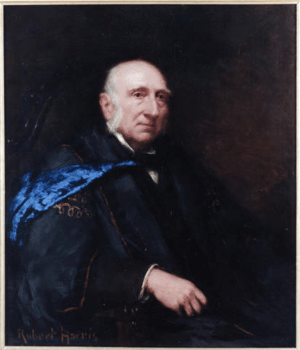Richard William Heneker facts for kids
Quick facts for kids
His Worship
Richard William Heneker
|
|
|---|---|

Portrait of Heneker
|
|
| Mayor of Sherbrooke | |
| In office 1868–1869 |
|
| Succeeded by | Louis-Edmond Panneton |
| Personal details | |
| Born | May 2, 1823 Dublin, Ireland |
| Died | February 5, 1912 (aged 88) Bournemouth, England |
| Spouse | Elizabeth Tuson |
| Children | 3 |
Richard William Heneker (born May 2, 1823, in Ireland – died August 15, 1912) was an important Canadian businessman. He was of Irish background. In 1855, he moved to Canada and settled in Sherbrooke, Quebec.
For about 50 years, Heneker was a very influential leader in the Eastern Townships region. He worked to help English-speaking people in Sherbrooke. He also wanted to build a strong local economy. He was the first chairman of Bishop's College School. He also served as a Chancellor of Bishop's University.
Contents
Early Life and Education
Richard William Heneker studied at University College School in London, England. After that, he took private lessons to learn about architecture.
Heneker's Career Journey
Working as an Architect in England
When he was 19, Heneker started working for Charles Barry. Barry was the architect who designed the Palace of Westminster in London. Heneker worked there until the late 1840s. Then, he started his own architecture business.
He often showed his drawings at the Royal Academy of Arts. For example, in 1846, he won second prize in a competition. This was for his design of a railway station. In the early 1850s, he became a member of the Royal Institute of British Architects. He ran an architecture office with a partner, Frederick Lawford.
Building Businesses in Canada
Heneker moved to Canada in 1855. He first visited Lowell, Massachusetts, in the United States. After that, he decided to settle in Sherbrooke.
He became very involved in managing businesses there. In 1855, the British American Land Company (BALC) made him their commissioner in Sherbrooke. This company was created in 1832. Its goal was to buy and develop a lot of land in the Eastern Townships. This land was called Crown Land. The company wanted to help British people settle in this part of Lower Canada. Richard William Heneker managed this "land company" for 47 years.
In 1866, Heneker became a part-owner and co-founder of Paton & Co. This was a manufacturing company. In 1868, it was renamed the Paton Manufacturing Company of Sherbrooke. Heneker became the president of this company. Its woolen factory was the biggest employer in Sherbrooke for many years.
Heneker also helped start the Bank of Eastern Townships. In 1874, he became the bank's president. From 1892 to 1902, Heneker was also the president of the Sherbrooke Gas and Water Company.
Helping the Community
Besides his business work, Heneker was active in local politics. He also helped the Protestant and English-speaking people in the Eastern Townships. In 1859, he joined the board of directors for Bishop's College Lennoxville. He became vice-chancellor and chairman of the board in 1875. From 1878 to 1900, Heneker was the chancellor.
Heneker is also known for starting the Sherbrooke Protestant Hospital. He led the effort to establish it. He was the first president of the hospital's board from 1888 to 1902. Heneker also helped the Church of England in various ways. He was a delegate to many church meetings.
He also helped several groups that encouraged English-speaking settlers to move to the Eastern Townships.
His Time in Politics
Heneker ran for election in 1867 for the Sherbrooke area. However, he lost to Joseph Gill Robertson.
Heneker was elected as a city councilor for Sherbrooke from 1867 to 1868. He was also a councilor from 1876 to 1882. On January 20, 1868, he was elected as the mayor of Sherbrooke. He took over from Joseph Gill Robertson. He was elected mayor again by the city councilors for one year in 1877.
His first time as mayor was short. He was often away from city council meetings. Because of this, he could not finish his term as mayor. J.G. Robertson replaced him in an early election.
See also
- British American Land Company
- Sherbrooke
- List of mayors of Sherbrooke

